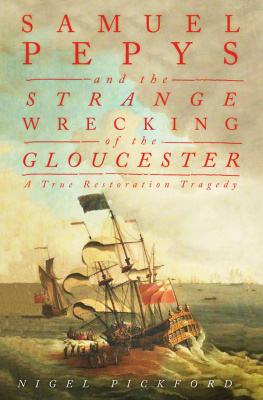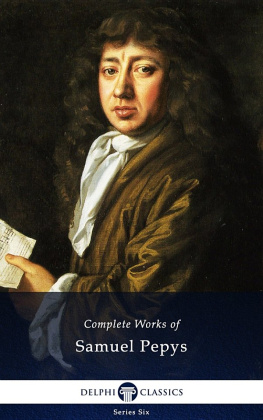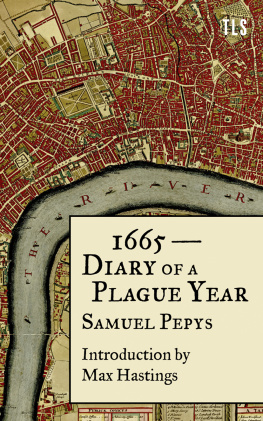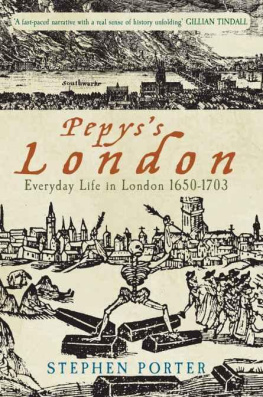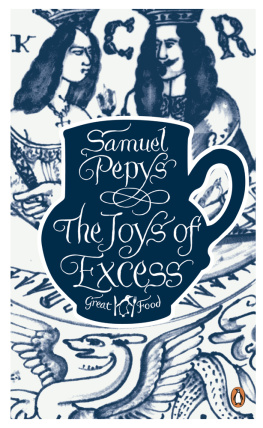This edition first published in paperback the United States in 2009 by
The Overlook Press, Peter Mayer Publishers, Inc.
141 Wooster Street
New York, NY 10012
Copyright 2007 by James Long and Ben Long
All rights reserved. No part of this publication may be reproduced or
transmitted in any form or by any means, electronic or mechanical,
including photocopy, recording, or any information storage and retrieval
system now known or to be invented, without permission in writing from the
publisher, except by a reviewer who wishes to quote brief passages in connection
with a review written for inclusion in a magazine, newspaper, or broadcast.
ISBN 978-1-468-30619-4
For Annie, Harry and Matilda
Seventeenth-century dates can be confusing. Legally, the new year did not begin until 25 March (Lady Day). However, in common practice it began on 1 January. As a result, both dates were given in the form 1 January 1678/79. We have followed common practice in beginning the new year on 1 January.
Until 1752, British (Old Style) dates were ten days behind their European (New Style) equivalents. Dates in this book are generally Old Style unless otherwise stated.
In the interests of clarity, we have modernised spellings.
The authors would like to thank the master and fellows of Magdalene College, Cambridge, for access to Pepyss manuscripts. Dr Richard Luckett, Pepys Librarian, and Mrs Aude Fitzsimons generously lent their support, enthusiasm and knowledge. We are greatly indebted to them.
Our thanks to the librarians at the British Library, the Duke Humfreys Library, Oxford, and the National Archives, and to the staff at the Institute of Historical Research. We are grateful to the Comptroller of Longleat for permission to use material from the Henry Coventry archive, and to Dr Kate Harris, curator of Longleat Historic Collections.
Dr C. S. Knighton and Guy de la Bdoyre were kind enough to answer our questions. J. H. L. Puxley generously shared his portraits with us, as did James P. S. Thomson, the Master of Charterhouse. James Rhys provided an informative tour of the Houses of Parliament. Thanks also to David Burnett, Will Hutton and Pete and Liz Strange.
Victoria Hobbs at A. M. Heath, the best possible agent and friend, saw the point straight away. Thanks to Henry Volans and to our editor at Faber, Julian Loose, who have steered us with patience and a deft touch.
The rest of the Long family, in putting up with arcane mealtime debates, a house overwhelmed by papers and our reading them numerous drafts, have proved themselves a tolerant and fine-spirited lot, and this book is dedicated to them.
: National Maritime Museum, London.
He was led outside, the heat of their wrath at his back. As he emerged through the stone archway, fat drops of spring rain were falling from a dark sky.
His eyes suggested a judicious mind and he carried authority, but his fleshy lower lip and extra chin told a more sensuous story of good food, wine and women. The inquisitive little frown was permanent though deepened at this moment, perhaps, by indignation. His colleague arrived beside him and, under guard, they began the journey away from their old lives. His name was Samuel Pepys. He was an MP. He had just been accused of treason in the whitewashed chamber of the House of Commons.
The heavy sky rumbled. They were led away from the seething Commons, through the houses that spilled down to the steps on the bank of the Thames and into a boat. Nearby, Pepyss luxurious private barge, decorated with paintings of little seas, lay ignored at its mooring.comfortable lodgings over it, now entirely beyond his reach.
The modern world knows Pepyss loves, ambition, anxieties and transgressions through his Diary, but at this moment it remained his secret, closed ten years earlier and protected from prying eyes by his neat shorthand.
The men who had condemned him in the Commons knew him only for his public work as Secretary to the Admiralty; a short man who cut a mighty figure in King Charles IIs administration. Nonetheless, it had come as an immense surprise to be accused of having sold England to her oldest enemy.
The Kings ramshackle palace of Whitehall sprawled along the bank, then gave way to the gardens of the Strand mansions running down to the river. As the boat rounded the bend, the quiet, upstream world of governmental and judicial power dropped out of sight and London stretched ahead. At its western outskirts St Jamess church was under construction in the opulent new courtier area around Piccadilly, and the garden of the Earl of Leicesters mansion had recently been developed and renamed Leicester Square. The buildings no longer reached over the streets at their upper storeys, and the sky seemed bigger.
Against the black clouds, the city was a sorry sight. Most of the spires ornamental extras in a rebuilding effort born of pressing necessity were not yet raised above the new churches.
The city was familiar to Pepys and his serious-faced fellow MP, prisoner and companion on this journey, Sir Anthony Deane. They knew the towering Monument to the Fire, its walls filled with the rubble of old St Pauls.
The tall buildings right across London Bridge blocked their view downstream. The barge rocked on the tide through the archway and rushed out into the port of London. There ahead, dominating the north bank, was William the Conquerors grim bastion, the Tower of London. The barge came alongside and the two men were escorted ashore and taken into captivity by officials of the Tower. Samuel Pepys found himself a prisoner in the medieval building which formed the final eastern marker, the end of the city, on contemporary maps. It had been protected from the Fire by the good fortune of an easterly wind. From here, Pepys had watched medieval London, the London of Shakespeare whose powerful kings could keep their servants safe under royal wings burn and disappear. Alone, with no hope of protection from King Charles, he faced a trial it would be almost impossible to win. If he lost, he would be executed.
In May 1660, nineteen years before Samuel Pepyss imprisonment in the Tower of London, Charles Stuart came down in triumph to the beach at The Hague. After nine years as an exile on the Continent he was preparing to sail for England and sit as king on the throne that had been denied him. The white sands of the Dutch coast were black with the people who came to watch his departure. When the Kings presence on the shore was made known to the English fleet waiting to collect him, its commander fired his ships guns. The rhythmic explosions of the salute fell out of time as the fleet joined in, a disordered cacophony of celebration. All day the guns fired; England had a king again.
When Pepys woke the next morning, his eye was red and sore but his spirits were high, for a new age was being born. Everywhere the old regime was coming to an end. The ships crews had been busy painting the royal coat of arms over the Commonwealth harp, and the King and his brother, the Duke of York, set to at a table on the Nasebys quarterdeck to make changes. Having no wish to travel back to England in a ship named after the Cromwellian Civil War victory which finished his father, Charles renamed her the Royal Charles, while the Richard, accompanying her, became the Royal James. On deck Pepys watched as we weighed anchor, and with a fresh gale and most happy weather we set sail for England.
He set these events down in a book he had bought at the end of the previous year. Its pages were white, and he had ruled neat red margins on to them. On 1 January he had begun his record. It was the diary of a poor man at the beginning of his career.



